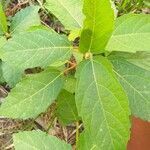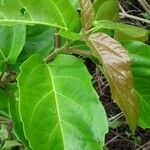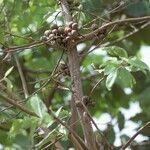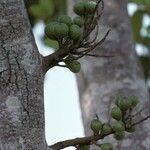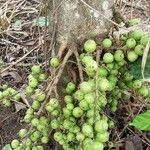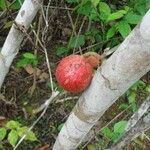A fig. This tree varies in form. It can be a small tree up to 6 m tall in dry places or a large spreading tree up to 12-24 m tall in forest. It normally loses its leaves for a short period. The bark is smooth and brownish grey. It has a thick trunk and shallow spreading roots. The leaves are alternate and leathery. They are oval with a pointed tip. The leaves are 10 cm long by 3 cm wide. They can be 23 cm long by 13 cm wide. They are red when young becoming green when mature. They are smooth and sometimes slightly hairy underneath. The leaf stalks are long and with a furrow on the upper surface. Twigs and leaves have milky juice. There are only a few small male flower near the opening of the fig and many female flowers. The fig is pollinated by a small wasp. The figs are roughly round and about 2-4 cm across. They have a prominent opening at the end. They are reddish-yellow when ripe. They hang from the trunk and old main branches. The pulp is sweet. Many figs form one long bunch.
Leaf lamina elliptic to ± ovate or oblong, sometimes subcircular or lanceolate, 4–20(32) x 3–13(16) cm., chartaceous to coriaceous, apex acuminate to acute, base subacute to cordate, margin coarsely crenate-dentate to repand or ± entire; superior surface smooth, sometimes scabrous, glabrous or puberulous on the proximal parts on the main veins, the inferior surface puberulous to tomentose, or glabrous and only the main veins pubescent; lateral veins (3)5–9 pairs; petiole 1.5–9 cm. long, 1–2 mm. thick, puberulous, ± hirsute or subtomentose sometimes glabrous, epidermis usually not flaking off when dry; stipules 1–3.5 cm. long, white to yellowish subsericeous, pubescent or hirsute to glabrescent, caducous.
Tree with rounded crown, up to 12(-25) m high. Leaves alternate, spiralled, thinly leathery, ovate to elliptic (55-200 x 20-130 mm), dark green, paler below, glabrous on both surfaces, base rounded to cordate, apex rounded to acute, margins widely and irregularly dentate; petioles 13-90 mm long. Syconia (figs) borne on much-branched leafless branches (trusses), main branches, trunk or roots (syconia borne just below soil level); figs round to pear-shaped, 28-40 mm in diam., usually hairless, green, spotted with minute cream-coloured spots, turning pink/red when ripe; stalk ± 10 mm long.
Receptacle obovoid to subglobose, often ± depressed-globose, often stipitate, at least when dry, 2–4 cm. in diam. when fresh, 0.5–2.5 cm. in diam. when dry, indumentum white to yellowish, ± puberulous to almost glabrous or densely tomentose to subvelutinous, red to dark orange at maturity.
Figs on branching, leafless branchlets up to 50(150) cm. long, on the older wood, down to the trunk, or figs occasionally in the leaf axils or just below the leaves; peduncle 5–20 mm. long, 1–3 mm. thick; basal bracts 2–3 mm. long.
Large tree, up to 25 m high. Leaves ovate to ovate-elliptic, glabrous, margin entire or distantly and bluntly dentate. Figs in long clusters on main branches and trunk, stalked, up to 40 mm in diameter, yellow and rosy.
Leafy twigs 2–5 mm. thick, white to yellowish (or brownish) puberulous, hirtellous, tomentose or hirsute to glabrescent, periderm usually not flaking off when dry.
Monoecious tree to 11 m, bark dark grey. Leaves elliptic to ovate, broadly toothed. Figs in panicles on trunk and main branches, 20-40 mm diam., red.
Tree up to 25(30) m. tall.
